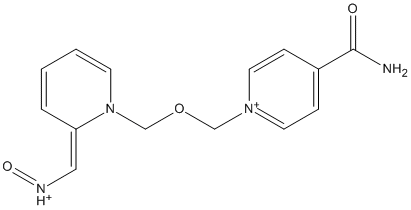HS-6
General
Type : Oxime, Bispyridinium
Chemical_Nomenclature : [(E)-[1-[(3-carbamoylpyridin-1-ium-1-yl)methoxymethyl]pyridin-2-ylidene]methyl]-oxoazanium\;dichloride
Canonical SMILES : C1=CC(=C[NH+]=O)N(C=C1)COC[N+]2=CC=CC(=C2)C(=O)N.[Cl-].[Cl-]
InChI : InChI=1S\/C14H14N4O3.2ClH\/c15-14(19)12-4-3-6-17(9-12)10-21-11-18-7-2-1-5-13(18)8-16-20\;\;\/h1-9H,10-11H2,(H-,15,19)\;2*1H\/b13-8+\;\;
InChIKey : ZSQUOZWXBXLUDF-LIYVDSPJSA-N
Other name(s) : 1-[[[3-(aminocarbonyl)pyridinio]methoxy]methyl]-2-[(hydroxyimino)methyl]-pyridinium,dichloride, HS 6, HS 6 (pharmaceutical), 3'-Carbamoyl-2-formyl-1,1'-(oxydimethylene)dipyridinium dichloride 2-oxime, 1-(((3-(Aminocarbonyl)pyridinio)methoxy)methyl)-2-((hydroxyimino)methyl)pyridinium dichloride
MW : 359.20
Formula : C14H16Cl2N4O3
CAS_number : 22625-23-6
CID PubChem :
InChIKey UniChem :
Iuphar :
Wikipedia :

Target
Structure : No structure
Families : No family
References
No reference